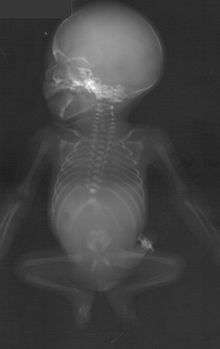Caudal regression syndrome
| Caudal regression syndrome | |
|---|---|
|
Sacral agenesis. | |
| Classification and external resources | |
| Specialty | medical genetics |
| ICD-10 | Q89.8 |
| DiseasesDB | 31157 |
| eMedicine | orthoped/618 |
Caudal regression syndrome or sacral agenesis (or hypoplasia of the sacrum) is a congenital disorder in which there is abnormal fetal development of the lower spine—the caudal partition of the spine.[1]
It occurs at a rate of approximately one per 25,000 live births.
Signs
This condition exists in a variety of forms, ranging from partial absence of the tail bone regions of the spine to absence of the lower vertebrae, pelvis and parts of the thoracic and/or lumbar areas of the spine. In some cases where only a small part of the spine is absent, there may be no outward sign of the condition. In cases where more substantial areas of the spine are absent, there may be fused, webbed, or smaller lower extremities and paralysis. Bowel and bladder control is usually affected.
Prognosis
There are four levels (or "types") of malformation. The least severe indicates partial deformation (unilateral) of the sacrum. The second level indicates a bilateral (uniform) deformation. The most severe types involve a total absence of the sacrum.
Depending on the type of sacral agenesis, bowel or urinary bladder deficiencies may be present. A permanent colostomy may be necessary in the case of imperforate anus. Incontinence may also require some type of continence control system (e.g., self-catheterization) be utilized. Occasionally if deformities of the knees, legs or feet would prove unresponsive to corrective action, amputation at the knee may be proposed.
Before more comprehensive medical treatment was available, full amputation of the legs at the hip was often performed. More recently, the 'amputation' (actually a disarticulation because no cutting of the bone is involved) is done at the knee for those who have bent knee positions and webbing between thigh and calf to enable more ease of mobility and better seating. Some children with knee disarticulation use prosthetic legs to walk. Prosthetics for children without substantial hip and trunk control is usually abandoned in favor of faster and easier wheelchair mobility as the child's weight and age increases. Children may 'walk' on their hands and generally are able to climb and move about to accomplish whatever they need and want to accomplish. Children more mildly affected may have normal gait and no need for assistive devices for walking. Others may walk with bracing or crutches.
There is typically no cognitive impairment associated with this disability. Adults with this disability live independently, attend college, and have careers in various fields. In 2012, Spencer West, a man with sacral agenesis and both legs amputated, climbed Mt. Kilimanjaro using only his hands.[2]
Etiology

The condition arises from some factor or set of factors present during approximately the 3rd week to 7th week of fetal development. Formation of the sacrum/lower back and corresponding nervous system is usually nearing completion by the 4th week of development. Due to abnormal gastrulation, the mesoderm migration is disturbed. This disturbance results in symptoms varying from minor lesions of the lower vertebrae to more severe symptoms such as complete fusion of the lower limbs. While the exact etiology is unknown, it has been speculated that the condition may be associated with certain dietary deficiencies including a lack or insufficient amounts of folic acid.
Sacral agenesis syndrome (agenesis of the lumbar spine, sacrum, and coccyx, and hypoplasia of the lower extremities) is a well-established congenital anomaly associated with maternal diabetes mellitus (not gestational diabetes). However, other etiologic factors are presumably involved, as demonstrated by the rare incidence of caudal regression syndrome (1:60,000) compared to diabetes. Certainly not all children born with caudal regression syndrome have diabetic mothers.
The dominant inherited sacral agenesis (also referred to as Currarino syndrome) is very often correlated with a mutation in the Hb9 (also called HlxB9) gene (shown by Sally Ann Lynch, 1995, Nature Genetics).
It may be the cause of sirenomelia ("Mermaid syndrome").
Synonyms
Synonyms for CRS:
- Caudal dysplasia
- Caudal dysplasia sequence
- Congenital sacral agenesis
- Sacral regression
- Lumbo sacral agenesis
Notable cases
- Johnny Eck, American freak show performer
- Kenny Easterday, played a fictionalized version of himself in the film Kenny
- Kurt Fearnley, Australian wheelchair racer
- Bobby Martin, American footballer
- Jessica Rogers, American wheelchair basketballer, wheelchair racer, swimmer and founder of iSACRA (International Caudal Regression Syndrome Association)
- Rose Siggins, actress (American Horror Story: Freak Show) [3]
- Spencer West, American motivational speaker, social activist
- Victoria Pendergast, first female Australian sit-skier at Winter Paralympics.
- Piyah Martell, transgender internet star [4]
- Kendra (Sanders) Schraml, Ms. Wheelchair Washington 2011 [5]
- Rebecca Dubber, New Zealand para-swimmer & Rio 2016 Paralympic bronze medalist
References
- ↑ Sonek JD, Gabbe SG, Landon MB, Stempel LE, Foley MR, Shubert-Moell K (March 1990). "Antenatal diagnosis of sacral agenesis syndrome in a pregnancy complicated by diabetes mellitus". Am. J. Obstet. Gynecol. 162 (3): 806–8. doi:10.1016/0002-9378(90)91015-5. PMID 2180307.
- ↑ ABC News
- ↑ http://www.cnn.com/2015/12/13/entertainment/actress-rose-siggins-dead/?iid=ob_homepage_deskrecommended_pool&iref=obnetwork
- ↑ http://www.dailymail.co.uk/health/article-1371069/Transgender-teenager-born-legs-says-I-wont-let-birth-defect-stop-star.html
- ↑ http://www.championnewspapers.com/news/article_7ed3bfc7-bb02-5517-91df-25f7118239cd.html
External links
- international sacral agenesis/caudal regression association
- Rarediseases.org
- Phreeque.com
- Mymultiplesclerois.co.uk
- Phreeque.com
- ABC News
- Medpix
